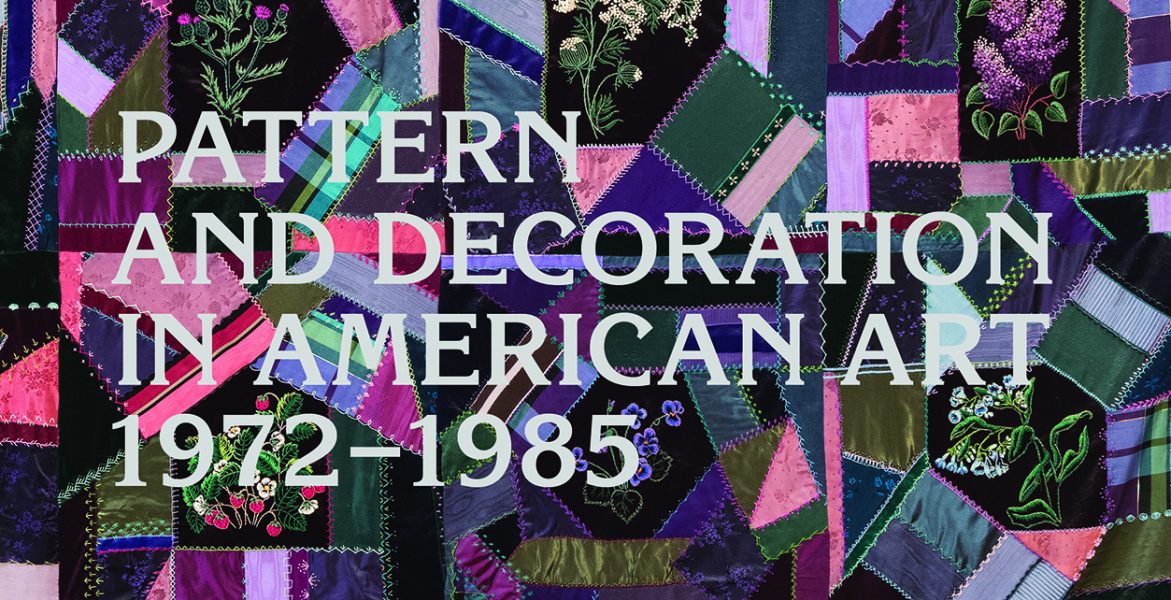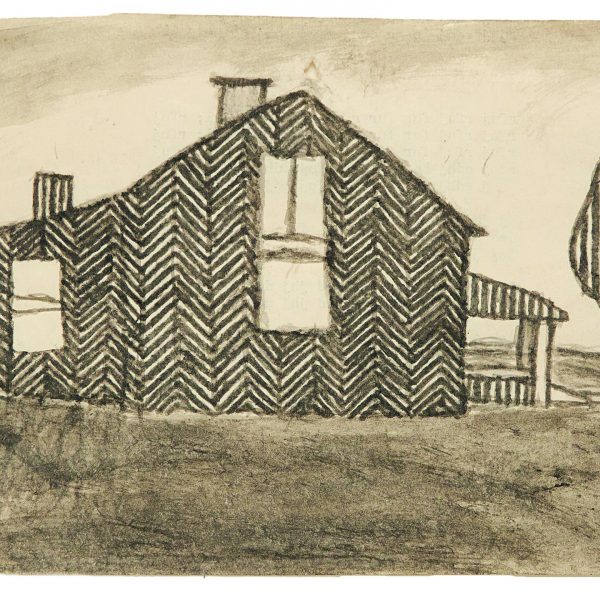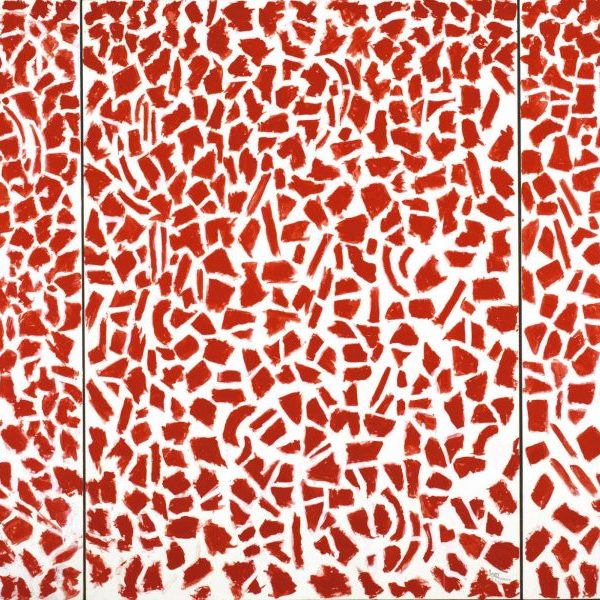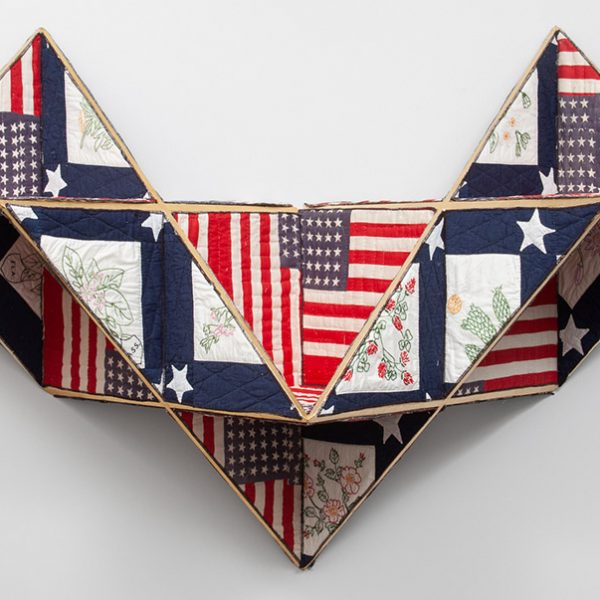Patterns of Promiscuity: The Pattern and Decoration Movement in American Art of the 1970s and ’80s
Interview with curator and author Anna Katz
by David Ebony
Pattern & Decoration (P&D) was an intense, but short-lived avant-garde art movement spanning the early 1970s, through the mid-1980s. It evolved from a coterie of young New York artists, but quickly took hold throughout the country, and also gained attention in Europe. P&D artworks may be characterized as brash, colorful, largely abstract works; but figuration was not unwelcome, as long as it was likewise bold, flashy, and sensuous, with a high degree of decorativeness. The exaltation of “the decorative” was one of the principal tenets of the movement. From the outset, P&D could encompass all mediums—painting, sculpture, installation, as well as clothing and other forms of wearable art, and interior decoration. Performance and video were also embraced by P&D—just so long as the subject matter and presentation were unapologetically uninhibited, and aimed toward a radical redefinition of beauty, as in works by Robert Kushner and Tina Girouard.
A touch of hedonism prevails in P&D works, in which decoration is paramount and excess is a virtue. Patterning, layered fabrics, sequins and glitter, and high-key paint tones abound in the work, while furniture, wallpaper and decorative objects are elevated to esthetically lofty positions they never held before. A shower curtain design by pioneering installation artist Judy Pfaff for art dealer Holly Solomon’s bathroom, for instance, or faux wallpaper created by artist Cynthia Carlson, could be wholeheartedly embraced as true works of art according to the P&D canon.

P&D offered an effective counter-measure to the prevailing—and often stifling—dictates of Minimalism, which had ruled the art world with patriarchal authority since the mid-1960s. A serious socio-political agenda further underlies the glitzy surfaces of P&D works—a visual manifesto centered on feminism, and an effort to overturn the traditional male-dominated view of art history as well as Western cultural chauvinism. At its best, P&D represents the first manifestation of cultural globalism. The Minimalist aim toward “purity” of form and expression were supplanted by P&D’s cross-cultural influences, resulting in “promiscuous patterns,” a phenomenon eloquently explained by The Museum of Contemporary Art, Los Angeles curator Anna Katz in the exhibition and book With Pleasure: Pattern and Decoration in American Art 1972-1985.

The publication, with contributions by Katz as well as authors and scholars Elissa Auther, Hamza Walker, Alex Kitnik, Kayleigh Perkov, Amy Goldin, and others, is the most comprehensive book on the subject produced to date. Assembled with the help of assistant curator Rebecca Skafsgaard Lowery, the exhibition of approximately one hundred works—one of the largest surveys of P&D ever mounted—debuted at the Museum of Contemporary Art, Los Angeles, on October 27, 2019. Its run, through May 11, was cut short due to museum closings in response to the Covid-19 pandemic. The exhibition was scheduled to appear this summer at the Hessel Museum of Art at the Center for Curatorial Studies, Bard College, in Annandale-on-Hudson, New York, June 27-December 11, 2020, and has now been rescheduled to open in June, 2021.
In the book, Katz traces the origins of P&D as a bonafide art movement to a 1975 meeting at the downtown Manhattan home of artist Robert Zakanitch to discuss shared ideas and goals among likeminded artists Joyce Kozloff, Miriam Schapiro, Tony Robbin, and others. There was an aim toward antihierarchical systems in art-making—the dissolution of traditional value systems of high and low art. Some P&D artists explored art’s relationship to math and science. Tony Robbin, one of the most inspiring art history professors I had as a college undergrad, explored the fourth dimension in painting, with mesmerizing compositions of ever-shifting layers of geometric patterns.

Architect and theorist Buckminster Fuller was a major inspiration for some artists associated with the P&D movement. He asserted that the human body was defined not by its materiality, but by the patterning of its materials. In the book, contributor Rebecca Skafsgaard Lowery points out that artists of the period studied DNA, fractals, and other structural patterns that seemed to underlie all of existence once you scratched the surface.
Recently, I spoke on the telephone with Anna Katz about the book and the exhibition. We discussed the theme’s evolution and its personal and public significance for her and for art audiences.
David Ebony With this exhibition and book, With Pleasure, you are introducing the Pattern and Decoration (P&D) movement to a whole new generation. Maybe I can start by asking you the basic question—how would you define the P&D movement?
Anna Katz The Pattern and Decoration movement emerged in the early 1970s in New York, Los Angeles, and art centers in between, like Chicago. It was fundamentally a group of artists who embraced in their works of the 1970s and ’80s, a wide range of patterns and motifs usually associated with decorative art, such as florals, or designs from patchwork quilts. The P&D artists challenged a longstanding hierarchy of high and low that was in place in Western art for centuries, that had placed fine art—painting and sculpture—above decorative or applied arts, ornament and craft.
This was seen at the time as a challenge not only to the values that had dictated Western art whereby painting and sculpture stood well above fabric design, mosaic, basketry, weaving and ceramics. Generally, it was a challenge to the Minimalist esthetic that ruled the day. The P&D movement countered the modernist dictum that “less is more.” These artists used textiles, feathers, glitter, and wild color combinations and overlapping patterns, with the idea that “more is more.”
DE How did you get involved with the movement? What was the attraction for you and the impetus for this show?
AK The origin story for me is that before I even worked at L.A. MoCA, I was hired to write about seventy-five wall labels for a permanent collection installation, with works by Franz Kline, Lee Krasner, Liz Larner, and also an artist named Kim MacConnel; and I wondered, who the hell is Kim MacConnel? In my research, I learned that he was central to this movement that somehow entirely escaped me, and seems to have been almost totally neglected by most art historians.
How did I get through to a PhD without being aware of this movement? It struck me that MacConnel’s work so closely resembled works that so many younger artists today are doing. The motivation for me was to explore the last influence of P&D that had yet to be fully assessed. As a scholar, it is exciting to research material that seems to have been left out at the margins of recent art history, and asking questions about it as if for the first time. And it is a time when those questions seem pressing and urgent.

x 279.4 cm). The Museum of Contemporary Art, Los Angeles, gift of
Paula and Allan Rudnick.
DE I often think of a younger artist like Jeffrey Gibson and others, who must have been influenced directly or indirectly by the P&D movement.
AK Jeffrey Gibson is a fine example. He is an artist who cites P&D as an influence, as does Sanford Biggers, who has been using historic quilts in his work for some time. The rise in ceramics as a prominent art form can also be linked to P&D. I am a little reluctant to name names, but here in Los Angeles, consider the ethos of someone like Laura Owens, who has invested her painting with a nonhierarchical visual vocabulary; or Rebecca Morris, who works in an abstract tradition that challenges conventions of taste and sensibility. Aside from those examples, even when looking at the work of young artists today, just out of school, I see so much Matisse, and so many allusions to decorative and ornamental painting.
DE It seems trendy again, but P&D went through such a long and rough period of being sidelined or dismissed altogether by the art-world status quo. Could you talk about the taboos against the P&D movement, or resistance to it? And how did it eventually overcome that kind of intense negative perception?
AK P&D enjoyed a moment of enthusiastic critical reception, commercial success, and institutional recognition in the mid- and late 1970s. There were exhibitions throughout the U.S. And in Europe, the movement was very well received at the time. In New York, Holly Solomon was the most successful commercial gallery in actively promoting P&D; and works entered the collections of all the prominent museums here and around the world—MoMA, the Met, the Art Institute of Chicago, L.A. MoCA, and so on. By the early 1980s, it seems that P&D had been eclipsed by Neo-Expressionism.
Ironically, P&D and Neo-Expressionism have a lot in common. Both can be seen as Postmodern movements that embrace appropriation, reference and citation, mixing high- and low art, and using unconventional materials. But there was one crucial difference. P&D was entirely sincere in its intentions. It is a celebratory art—it embraces kitsch and craft, and ornamental patterns. Its relationship to its sources, as a form of appropriation art, was never one of detachment. By contrast, detachment, irony, and a kind of pervasive cynicism became hallmarks of Neo-Expressionism, and of 1980s Post-Modernism in general.
Part of the problem was a deep-seated historical bias against the fields of craft and decoration that were often deemed “women’s work”—art and artifacts that were traditionally made by women, and which the P&D artists so admired. Although there were quite a few men among the P&D artists—and not all of the women artists were necessarily feminists by self-identification or by definition—the movement’s radical gesture was basically feminist, and shaped by feminist art-historical methods.

overall 94 1/4 × 172 3/8 in. (239.4 × 437.83 cm). Whitney Museum
of American Art, New York, gift of an anonymous donor. Digital image
© Whitney Museum, NY.
DE Do you think that the renewed interest in P&D today is directly connected to the new women’s movement, or the feminist movement that has reemerged in the past few years?
AK I think that’s plausible. When you have a president who boasts about grabbing women; you then find some aspect of the culture that has to reimagine its relationship to feminism in response. Artists, curators and writers in opposition to these recent developments have been looking back into the playbook to see how it was done in the past. They look for inspiration and examples in the late 1960s and early ’70s.
One work in the show, a video by Tina Girouard, titled Maintenance III [1973], is a particularly striking example of a feminist artwork within a timely political context. The performer is the artist herself, but you never really see her face. It’s a tightly cropped image of her you see throughout the approximately 30-minute video in which Girouard “maintains” a set of floral-patterned chiffon fabrics that she calls “Solomon’s lot,” after the uncle who gave them to her. She is shown sewing them, folding, washing, ringing, and rinsing them. While she’s doing this, she’s listening to Top 40 tunes on the radio—Sly and the Family Stone, Pink Floyd, Wings, etc. The music’s interrupted by an advertiser saying, “Come to the Kitty Cat Club,” or whatever it is, Saturday night on Route 95. And then there’s a news report, and it’s on the Watergate hearings—because it’s 1973.
DE In your essay for the book, discussing the relationship of feminism to the P&D movement, you regard Miriam Schapiro as a principal protagonist. Could you say a few words about her contribution?
AK Miriam Schapiro was a pioneer in P&D, and a mentor to many of the artists involved in the movement. A little older than most of them, she was born in 1923 and had a successful career in the 1950s and ’60s, exhibiting with André Emmerich Gallery in New York, first showing Abstract Expressionist paintings and subsequently, hard-edge Minimalist compositions. She moved to California in the late 1960s, and her feminist consciousness was raised then, when she was about 50 years old. She co-founded, along with Judy Chicago, the feminist art program at Cal Arts [California Institute of Arts], in 1971, which culminated in the Womanhouse installation of 1972.
That particular work is the starting point for this show. Central to Schapiro’s practice as an artist and her feminist activism is “femmage,” a portmanteau she coined combining female and collage, as well as joining “femme” and “homage,” as an homage to women. She was motivated to validate the art of women, the creative, artistic and intellectual achievements of women that are worthy of esthetic merit and consideration. She understood that the nearly total exclusion of women from the history of art did not indicate that women had not been making art, but that their art had not been taken seriously enough by the pervasive male-dominated views of art history. With “femmage,” she was focused on assemblage-like works and justifying activities that were for centuries traditionally associated with women—from quilt-making to interior decoration and cooking—countering the status quo’s judgement of these endeavors as trivial or merely decorative.

DE In the book, you make a distinction between “decorative” versus “domestic” art. Could you elaborate on that idea?
AK In Miriam Schapiro’s case, the locus of the decorative and the thrust of it, has to do with the domestic. In her work, she wanted to underscore the fact that historically women did not have access to art schools or studios like male artists did. Their studios were their homes, the place where they expressed their creativity. For Schapiro, the home was the place and site of the decorative. For other artists in the exhibition, the decorative is not necessarily related to the domestic. The decorative for them would be related to non-Western art—Moroccan tiles, for instance, Oaxacan pottery, or Turkish rugs. These art forms were likewise dismissed, in the Western art canon, as inferior to fine art.
DE You also consider Amy Goldin as a key curator in the movement, in a section in the book called “Promiscuous Patterns.” I love that title, by the way! Goldin was very much interested in Islamic art; and you discuss the importance of The Metropolitan Museum of Art’s galleries for Islamic art opening in 1975.
AK Amy Goldin causally mentions the term “promiscuous” in an essay titled “Patterns, Grids, and Painting,” published in Artforum in 1975. It’s a foundational text in the P&D movement. I understood her use of the term “promiscuity” as historically relevant and conceptually generative for artists and their relationships to pattern. Modernism’s problem with pattern was that they are superficial, non-essential, that they were merely applied to a surface. In Modernism’s pursuit of purity, the aim was to strip away anything that was extraneous. Therefore, decoration in general and pattern in particular were the first to go. I was interested in seeing how the P&D artists dealt with the promiscuity of patterns. Pattern is not specific to any medium or material; they could combine patterns of a rug on the floor, in an article of clothing, or in the mosaic dome of an Islamic mosque. It’s this kind of promiscuity, a non-virtuous virtue that appealed to the P&D artists, and interests me. In a way, this impurity or non-specialization harbored a special power that the artists wished to harness.
DE Travel was also important to the artists, in considering works by painters Valerie Jaudon and Joyce Kozloff, for example. First-hand experience with non-Western cultures—Asian, African and Native American culture, for instance—that was crucial to the development of P&D, and its global aspect that seems particularly relevant today.

(304.8 × 274.32 cm). Collection of Thomas Solomon and Kimberly
Mascola, © 2019 Valerie Jaudon / Licensed by VAGA at Artists
Rights Society (ARS), NY. Photo by Zak Kelley
AK Traveling abroad has been important for artists for generations, of course. It’s an integral part of the artistic impulse, you could say, and education. It was particularly important for P&D artists, many of whom traveled the world—to favorite places like Spain, Morocco, Turkey, Iraq, Iran, China, Japan, Mexico, and so on. The artists were looking at and looking for different ways of conceiving of the decorative. In many non-Western cultures or artistic traditions, there is no hierarchy of fine art and decorative art. In many cultures there is no distinction between art and craft, or fine art and applied art. This was enormously valuable to P&D artists as they were analyzing, and seeking to rethink the bias against the decorative in which they had been inculcated—in Western European art histories and theories. Again, this movement was motivated in large part by feminism, and sought to undermine or overturn the gender and racial biases that had been used to create the historical categories and value systems of Western art.
DE What were some of the surprises for you in the course of organizing the exhibition? And what do you hope that viewers come away with from the show, and the book?
AK There were two surprises for me in the process of curating With Pleasure. One is that there were no exhibitions of P&D when I started to work on it, but in the three years it took to realize the exhibition, several other P&D shows have emerged. This let me know that other people were seeing what I was seeing with regard to the importance of the P&D movement at this moment, and that I was not an outlier.
The other surprise for me was to see how easy it is to unlearn your taste. I didn’t embark on this show because P&D reflected or validated my own personal esthetic taste and judgement. I was motivated as a scholar to research the movement, which seemed to be an unfairly neglected area of recent art history. My own taste changed not just from looking at these works but from spending time with the artists. The experience made me think about and analyze my own biases when looking at art, and in that way, forced me to unlearn my taste.
I certainly hope that readers will come away with a different—and better—understanding of this period in American art, and see that there was much more going on than has been previously or consistently presented. I also hope that they rethink their taste in art as much as I did in the process of putting the exhibition together.
Anna Katz is curator at The Museum of Contemporary Art, Los Angeles.
David Ebony is a contributing editor of Art in America magazine, and the author of numerous artist monographs. He lives and works in New York City.


























